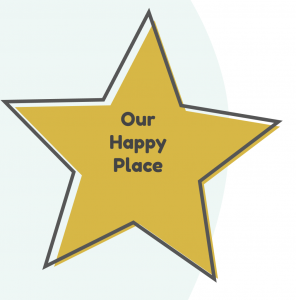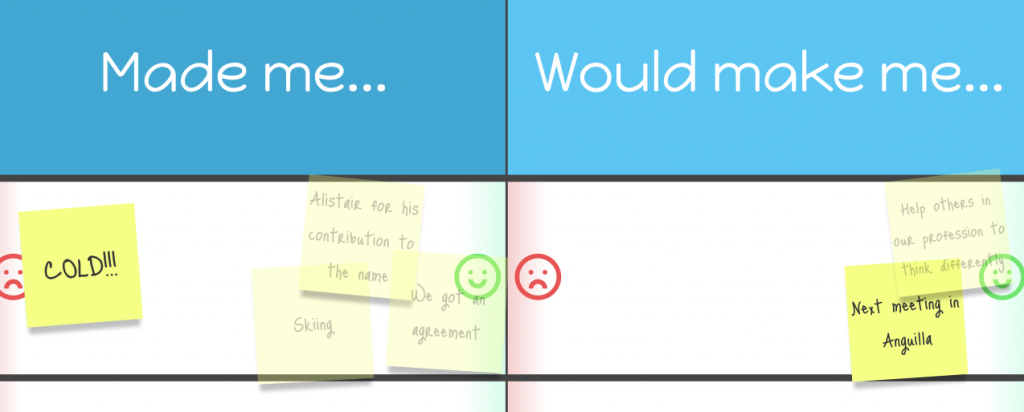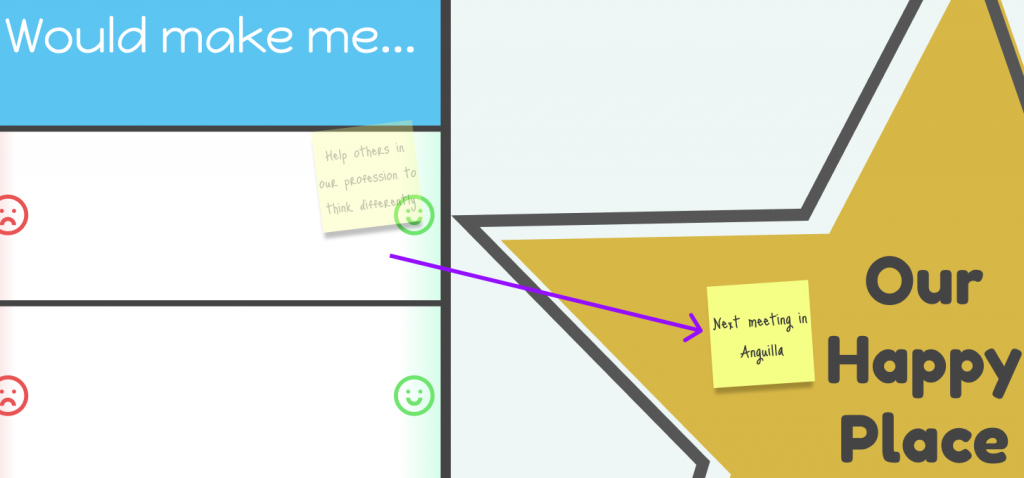Retrospectives are my favorite Scrum Events by far. Not only are they a fantastic opportunity to inspect and adapt, but also to get creative, bond, and have some fun.
There are thousands of retrospective exercises out there, even though the event is very simple at its core. It is how you approach each of them that makes them unique, as the language or the routine used can dramatically change the outcome and the impact on the team.
From time to time, I come up with an exercise of my own that I reckon can provide a new perspective on how to approach this activity and offer additional benefits.
Today, I want to tell you about one I call the Happy-O-Meter, a retrospective about happiness with a strong focus on improving openness and increasing individual feedback.

Anatomy Of The Happy-O-Meter
The structure of the Happy-O-Meter is pretty straightforward. It has basically two elements: a Main Board and an additional area called Our Happy Place.
Our Happy Place is where we will stack cards with improvements. I usually place it on the right side of the canvas and try to make it stand out to reinforce the team’s focus on tangible outcomes.

The Main Board is a table with a swim lane per each team member and three columns:
- I am…
- Made me…
- Would make me…
Each column has a Less Happy Zone on the left and a Happier Zone on the right, which I usually represent in red and green, respectively, and some visual cues such as sad/smiley faces or minus/plus signs.

Lastly, we will need cards so team members can participate, so we will place at least three per person next to each swim lane.
And that’s it; we are ready to go!
Placing The Cards
This retrospective strongly focuses on enhancing openness and transparency at an individual level. With that in mind, every participant will place at least one card on each column. It does not matter what the cards are about; we want people to share, even if it is just a tiny little bit of what is in their minds.
We will start with the I am... column, where we will add just one card with our name. The goal is to indicate how we are feeling compared to the beginning of this iteration by placing it closer to the Happier Zone on the right or to the Less Happy Zone on the left.
After that, we will look back to what happened during this iteration and how it affected us in the Made me… column. Here, cards will contain things or people that made us more or less happy during the iteration, again using the proximity to the appropriate Zone to share our feelings. It is a great place to bring up pain points, share newfound improvements, or take a moment to thank our colleagues for what they did for us.
Lastly, the column titled Would make me… is there to help us think about our future. What is it that we hope for? What do we fear that could happen? What would be a nice surprise? Once again, the Zones will allow us to express ourselves.
As you can see, Zones are extremely important. It is worth noting that they are continuous and gradual. The closer a card is to the end of a zone the stronger we imply the feeling is. Conversely, we understand a card in the middle of a column implies neutrality.
All in all, a swim lane should eventually look something like this:

Once everybody is done adding cards, it is time to comment on them.
Opening Up
Again, we want to give voice to the individuals in the team, so now that we have placed our cards, each participant will read theirs. I like to start each turn by asking the speaker: “How are you feeling?” I want them to know we are genuinely interested in them and that we are there to listen. It also sets up the stage for the I am… column which often is pretty straightforward and also serves as an ice breaker.
Then, we follow up with Made me… which is the purest retrospective part of the exercise. If there is a topic here that spans through several cards, which are also placed under Would make me…, I prefer to follow with those to explain the whole topic at once, with a consistent narrative, and discuss with the team what we can add to Our Happy Place.
If not, we can complete all cards in Made me… and continue with Would make me… afterward.
At the end of each turn, I will ask the participant how they feel about the outcome of their turn, offering them a moment to reflect and appreciate what just happened. Then, we thank them for sharing their thoughts before continuing with the next colleague.
I know it may sound complicated, so let me illustrate with an example.
Jim’s Turn
We start by asking our friend Jim how he feels, and it turns out he is considerably happier now than he was at the beginning of the iteration, as can be seen in the I am… column.

Still, he did not like how cold Snowbird was during this iteration, so for the next one, he wants to go to Anguilla in the Caribbean. This means he added the following cards to each column:

When he gets to talk about the cold, instead of continuing to read everything he has under Made me…, Jim will go on with the related card under the Would make me… column and tell the team how happy he would be to meet in Anguilla for their next gathering, eventually proposing the idea for the upcoming iteration.

After discussing this, if the team agrees this would make them happy, we will move the card to Our Happy Place and commit to trying our best to make it possible in the future.

After this topic has been agreed upon, Jim will go back to the Made me… column and continue sharing his thoughts with us. During this process, we will discuss ways to make him happier and ways to avoid things that would have the opposite impact.
Once he is done with his cards, I ask Jim how he feels about the outcome of his turn, and, thank him for sharing his thoughts before continuing with the next colleague.
Wrapping Up
We keep going until all swimlanes are discussed, and Our Happy Place is -hopefully- full of brilliant ideas. After that, similar to what we did individually, I like to ask the team how they feel about what they just discussed and the upcoming iteration.
This helps to get a better sense of the status of the team after the retrospective, which is very important, given we were aiming to improve team dynamics during the exercise itself.
We finish up with a brief but very useful conversation on how to proceed now. Often supported by the content that is in Our Happy Place, it should set the right mindset to face the upcoming iteration with a sharp focus on being happier.
One Final Happy Place
In my limited experience, I have observed that the Happy-O-Meter produces positive changes in the way teams interact, even from the very first attempt. However, as with any other retrospective exercise, it requires practice to get the best results it can offer At the same time, excessive repetition can dull it and reduce its effectiveness.
One of the strengths of the Happy-O-Meter is it can give a substantial amount of information at a glance, mainly thanks to where the cards are placed in the Zones. For example:
- Most cards to the right in the I am… as a sign of the team feeling it was a good iteration.
- One lane that varies compared to the rest may indicate someone with a different perspective.
- Lots of cards on the left under Would make me… indicate concerns or pessimism about the future.
As I said earlier, every team member should participate and add at least one card to each column. If this becomes a problem, I would question if we are making visible a symptom of a deeper issue. Do participants feel engaged? Is there real psychological safety in our work environment? Does the team find value in retros?…
When using a Happy-O-Meter to increase transparency, we must be mindful that a group of people not used to giving feedback is not likely to be used to receiving it either. It is crucial to maintain the right tone for the discussion during this exercise by being vigilant, constantly reading the room, and diligently facilitating when needed.
The truth is, that will not be a common issue. The natural course of things is that topics tend to be lighter at first and get more serious with time, which is usually balanced off because trust and understanding tend to develop at a similar pace.
Happy-O-Meters can be fairly time-consuming, especially in larger teams -not so much depending on the length of the iteration. I recommend trying to keep it under reasonable parameters but also accepting that it is not a quick meeting. Again, in the pursuit of enhancing communication, we must listen and make people feel listened to. Trying to force the timebox by rushing or skipping topics can be counterproductive.
Using a whiteboard and stickies is more than enough to enjoy an in-person Happy-O-Meter. Tools such as Miro, Figma, Lucid, or Microsoft Whiteboard can work great if you want to set up an online version. Despite not loving it, I have used the latter because of its native integration with MS Teams and accessible learning curve for the team. For the design that appears in this post, I used Figma. You can find it here if you want.
And that is all. I hope you find the Happy-O-Meter useful if you give it a try.
Thanks for reading!
